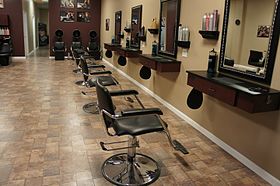This is an old revision of this page, as edited by HalR2002 (talk | contribs) at 20:13, 11 December 2022. The present address (URL) is a permanent link to this revision, which may differ significantly from the current revision.
Revision as of 20:13, 11 December 2022 by HalR2002 (talk | contribs)(diff) ← Previous revision | Latest revision (diff) | Newer revision → (diff) Hair and cosmetic treatment salon' "Hair salon" redirects here. For the video game known as "Hair Salon" in Europe, see Picture Perfect Hair Salon. Not to be confused with beauty store.| This article may require cleanup to meet Misplaced Pages's quality standards. The specific problem is: Outdated content and references, lacking information and (reliable) inline citations, Verify citations; Remove uncited opinion/narratives; needs re-organization; What version of English? Consider TNT? Please help improve this article if you can. (August 2022) (Learn how and when to remove this message) |
| This article may require copy editing for grammar, style, cohesion, tone, or spelling. You can assist by editing it. (August 2022) (Learn how and when to remove this message) |

A beauty salon or beauty parlor is an establishment dealing with cosmetic treatments for people. Other variations of this type of business include hair salons, spas, day spas, and medical spas.
Beauty treatments
Massage for the body is a beauty treatment, with various techniques offering benefits to the skin (including the application of beauty products) and increasing mental well-being. Hair removal is offered at some beauty salons through treatments such as waxing and threading. Some beauty salons also style hair instead of requiring clients to go to a separate hair salon. Some also offer sun tanning via tanning beds.

Another popular beauty treatment specific to the face is known as a facial. The perceived effects of a facial mask treatment include revitalization, healing, or refreshment of the skin. They may yield temporary benefits (depending on environmental, dietary, and other skincare factors). Although customers seek out these services for anti-aging or anti-inflammatory results, there is little to no objective evidence that there are any long-term benefits to the various available facial treatments.
Specialized beauty salons known as nail salons offer treatments such as manicures and pedicures for the nails. A manicure is a treatment for the hands, incorporating the fingernails and cuticles and often involving the application of nail polish. A pedicure involves treatment of the feet, incorporating the toenails and the softening or removal of calluses.
Industry
United States
Beauty salons have proven to be a recession-proof industry across the United States. Although sales had declined from 2008 highs due to the Great Recession, they remain robust with a long-term positive forecast. Even though during recessions, consumers tend to be more price-conscious, spending continued to increase. With rising per capita incomes across the United States since 2015, beauty salons boomed with the industry generating $56.2 billion in the United States. Hair care was the largest segment, with 86,000 locations. Skincare was expected to have revenue of almost $11 billion by 2018. This growth was driven in part by an increasing awareness of the importance of skin care among American women, but also specifically due to an increase in the market for men. In 2020, the market was distributed widely across America, with a concentration in the Northeast and Midwest. There was also a growing trend in boutique salons popping up and leveraging online marketing to gain customers and compete with the franchise chains. In 2014, the US Labor Department estimated employment in the United States increased 20% between 2008-2014, with the greatest employment growth from skincare specialists. Beauty salons employ cosmetologists specializing in general beautification techniques. Cosmetology licensing requirements vary from state to state, and depending on which specific type of license is desired, and depending on which specific type of license was desired: general cosmetologist, hair stylist, esthetician, manicurist, barber, electrologist, or other.
India
Beauty parlours employed 3.4 million people across India in 2013. The industry was expected to employ 12.1 million workers by 2022. Services typically include facials, skin-lightening bleaches, waxing, hair coloring, and hair straightening.
See also
References
- "Beauty Salon | Definition of Beauty Salon by Lexico". Lexico Dictionaries | English. Archived from the original on October 3, 2019.
- "Benefits of massage therapy". Mayo Clinic Health System. Retrieved 2022-11-04.
- "You Asked: Should I Get a Facial?". Time. Retrieved 2022-02-05.
- "Some beauty salons style hair instead of going to a separate hair salon? – Delicacy Salon & Spa". Retrieved 2022-12-11.
- "Some beauty salons style hair instead of going to a separate hair salon? - The Beautybar". beautybar.sr. 2019-05-20. Retrieved 2022-12-11.
- "2019 Beauty Salons Industry Statistics & Market Research Report - AnythingResearch". www.anythingresearch.com.
- "Beauty salons have proven to be a recession-proof industry? – Delicacy Salon & Spa". Retrieved 2022-12-11.
- "2020 U.S. Beauty Salons Industry-Industry & Market Report". www.marketresearch.com. Retrieved 2020-07-13.
- "U.S. Department of Labor | USAGov". www.usa.gov. Retrieved 2020-07-13.
- "US Bureau of Labor Statistics 2008-09". Archived from the original on December 4, 2008.
- "Beauty Salons and Beauty Salon Websites, Information and Listings - SalonBuilder.com". www.salonbuilder.com. Retrieved 2020-10-02.
- ^ Dalmia, Katyayani (2020). "Beauty Parlour". Keywords for India : a Conceptual Lexicon for the 21st Century. London: Bloomsbury Publishing Plc. pp. 76–77. ISBN 978-1-350-03927-8. OCLC 1134074309.
{{cite book}}: CS1 maint: date and year (link) - Elias, Ana; Gill, Rosalind; Scharff, Christina (2017), Elias, Ana Sofia; Gill, Rosalind; Scharff, Christina (eds.), "Aesthetic Labour: Beauty Politics in Neoliberalism", Aesthetic Labour, London: Palgrave Macmillan UK, pp. 3–49, doi:10.1057/978-1-137-47765-1_1, ISBN 978-1-137-47764-4, retrieved 2022-09-23